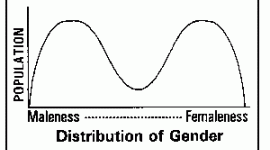Sexual Differentiation
A Tampa Gender Identity Program (TGIP) Abstract
The human embryo has the potential to develop as either a male or female. In the absence of the chromosome, gonadal and genital differentiation proceeds along female lines with no proven role for fetal or maternal hormones in this process. In the presence of chromosomes (short arm, known as the sex determinant region of the chromosome), the embryo and bipotential gonad differentiate into a teste. Glycoprotein known as a mullerian inhibitory hormone induces the growth of the mullerian duct primordia which will otherwise form the uterus and fallopian tubes in the upper 2/3 of the vagina. The testosterone induces development of the wolffian duct into the epididymis, vas deferens, and seminal vesicle. The Dehydrotestosterone induces development of the penis, scrotal sac, and prostate. The hormonal difference between male and female is a quantitative phenomenon not a qualitative phenomenon. The male makes a lot more testosterone, converting some fraction to estradiol. The female makes much less testosterone, but converts a much larger fraction to estrogen. The numerous tissues such as liver, brain, and especially muscle and fat (more often during puberty in females) are very important in sexual development and differentiation, in part related to the aromatase. These hormones have profound somatic effects, not only controlled by genetic factors but also changes of activity of the aromatase in organs such as the placenta, contributing in the expression of breast tissue. Especially in females, the placenta plays a major role in producing placental estrogen needed to offset the fetal excess of androgens from the adrenal gland.
The development of Neuroendocrinology has determined the importance of the LHRH in sexual differentiation (pulsated secretion of the hypothalamic hormones) suppressed during fetal life. The male pituitary gland characteristically secretes both FSH and LH in a pulsatile, but a relatively constant and sustained manner in which has been called a tonic release, where in the adult female the pulsated secretion of FSH and LH is cyclic. The concept of a male pattern imprinted on sex centers of the hypothalamus (usually by male testosterone on the brain, not dependent on dehydrotestosterone), in different species, suggests sexually that the morphic nucleus in the preoptic area of the brain is perhaps not so much regulated by the amount of testosterone, but also by the levels of aromatization of testosterone to estradiol in the central nervous system. Studies of multiple genetic disorders clearly state and provide strong evidence that gender identity is not coded primarily by sexual chromosomes or gonadal steroids. The gender identity (18 to 30 months) is formed early in the postnatal years. Recent studies in males with defects in estrogen receptors in humans prove also the importance in male maturation in bones for normal growth and development.
next: Multi-Dimensionality of Gender
~ all inside intersexuality articles
~ all articles on gender
APA Reference
Staff, H.
(2007, August 13). Sexual Differentiation, HealthyPlace. Retrieved
on 2025, December 1 from https://www.healthyplace.com/gender/inside-intersexuality/sexual-differentiation

